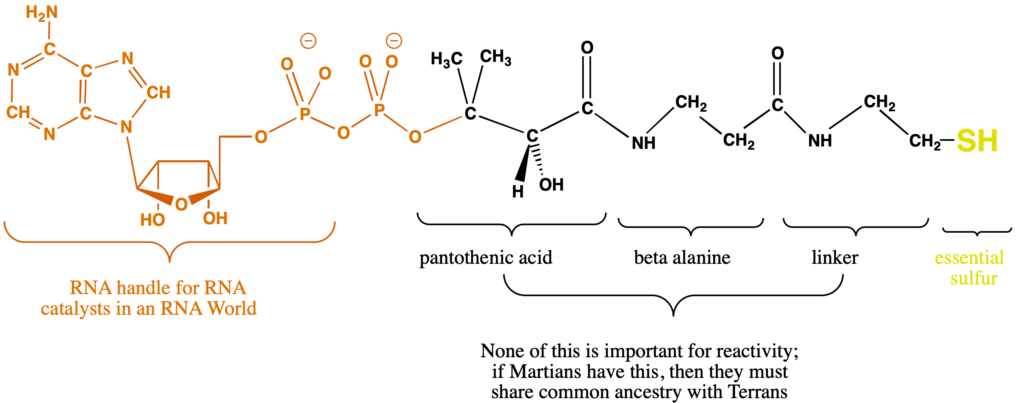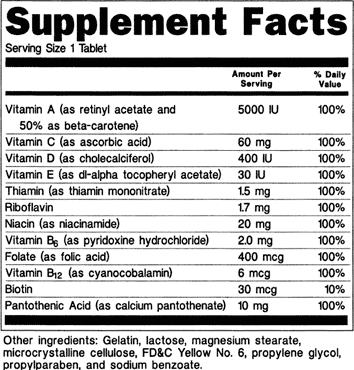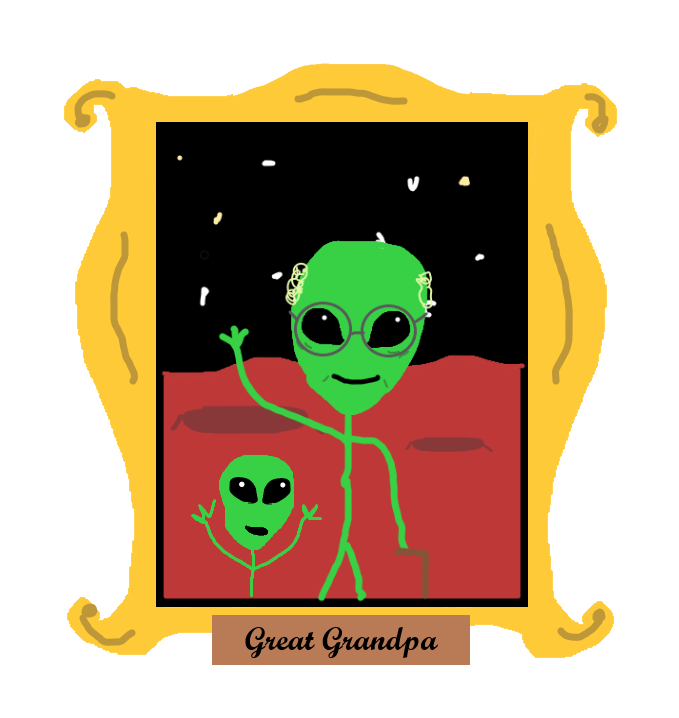Cite as: Benner, S. A. (2021) “If we are related to Martians, how would we know (Part 2)?”. Primordial Scoop, 2021, e0421. https://doi.org/10.52400/DWSV7683
Part 1 of this series asked: If we find life on Mars, could we tell whether it was related to life on Earth? The Part 1 solution suggested that we might first ask whether our Martian neighbors use cholesterol and other “terpenes” in their membranes. If Martians had terpenes, this would be consistent with shared common ancestry.
But it need not be. Since these molecules are “functional” in membranes, and membranes are likely universal in biology, their common use need not indicate common ancestry. Terpenes could have been independently developed in Martians and Earthlings, something called convergent evolution.
Now, we might sequence the protein enzymes that Martians use to make these compounds. Then, we would compare Martian protein sequences with the sequences of proteins that make terpenes on Earth. Part 1 showed a family tree where the similarities and differences between those protein sequences would allow us to place possible sequences from Martian Thing 1 and Martian Thing 2 on that tree. We could even estimate when Martian life diverged from Terran life, depending on whether we were looking at Thing 1 or Thing 2.

But the Part 1 description of Terran natural history was incomplete. It forgot an earlier part of that history, the part that occurred before Terran life invented protein biosynthesis. An entire episode of evolution has come and gone before the last universal common ancestor (with the acronym LUCA). LUCA is the entity that had two children, one that evolved to give Terran bacteria, and the other evolving to give the rest of known Terran life, including us. Sort of like the Biblical Cain and Abel.
The biosynthesis of proteins by translation of messenger RNA was invented before LUCA. The RNA World predated that. During the RNA world, RNA catalyzed all reactions in metabolism, including any reactions used to biosynthesize terpenes.
In 1989, with Andrew Ellington, we provided the first description of the metabolism of LUCA, including pieces of its protein biosynthesis machinery. We then extrapolated the metabolism of LUCA back to the RNA world. We showed why it was reasonable to infer that RNA life on Earth more than 3 billion years ago biosynthesized … terpenes.
In a moment, we will have more to say about this (remarkable) inference. But first, this more complete natural history means that Martian life and Terran life could also have diverged during the RNA world, before proteins took over as catalysts. We might encounter Martian Thing 3, which itself uses RNA as its only genetically encoded catalysts.

The problem? Sure, as this expanded tree implies, Martian Thing 3 might make terpenes. The Martian might even make terpenes by the same pathway that you and I make them. But RNA sequences are written in a four letter alphabet, G, A, C, and U. Protein sequences are written in a 20 letter alphabet: A,C,D,E,F,G … So the sequences of the RNA molecules that make terpenes in Martian Thing 3 will have no similarity to the sequences of any proteins that make terpenes in Terrans.
This blows away any hope that we could use sequence similarity to date, even approximately, when we diverged from our Martian cousins, if they diverged before proteins were invented. And as the RNA world may have ended as late 3 billion years ago, and Mars may have dried out before 3 billion years ago, intercourse between the two worlds to seed life from one to the other might well have occurred during the RNA world. Bummer.
However, we’re not out of ways to look for similarity. As we described in Part 1, the key step in making terpenes involves the reaction of acetyl “coenzyme A” (CoA), in pink, with acetoacetyl CoA, in blue.

Let me take you through this reaction. It forms a new bond between the -CH3 carbon adjacent to the C=O group of the magenta acetyl unit, on one hand, and the carbon atom of a C=O unit in the blue reactant. However, that -CH3 carbon is already attached to four things, the carbon of the C=O group and three hydrogens. The carbon has no more bonds to form. Four bonds is what carbon makes.
To form a new bond to the -CH3 carbon, one must first break off a hydrogen from that carbon, an H+ actually, leaving behind the electrons (green) in the broken C-H bond so they are available to form the new bond with the blue reactant.
Here, the sulfur atom (S) is important. The hydrogen can be removed from the -CH3 unit, but only if it is next to a C=O unit, and only if that C=O unit is also attached to sulfur.
This chemistry is universal. It is true on Mars, on Vulcan, and throughout the galaxy. So if Martians make terpenes using the connection of S, C=O, and -CH3 units, that fact need not indicate common ancestry. It’s functional. It could have arisen convergently.
However, it is time now to meet the rest of the CoA molecule. Here it is.

Coenzyme A links the necessary sulfur to two CH2 units to a nitrogen atom (N). The nitrogen atom is attached to a unit called “beta alanine”. Beta alanine also has a nitrogen atom, which is attached to a unit called “pantothenic acid”. The name may not be unfamiliar to you; pantothenic acid is in your vitamin pills. And the pantothenic acid is attached to two phosphate units and then to an RNA molecule, specifically, adenosine.

One can get the same reactivity from the sulfur atom with different attachments. Thus, the same chemical reactivity could come if the sulfur were attached to three consecutive CH2 groups, or four. Pantothenic acid itself is not really necessary. Beta alanine can be replaced. And the piece of RNA, adenosine, is so far away from the sulfur that it really does not influence its reactivity at all.
So why does CoA have a piece of nonfunctional RNA attached to it? It is not the only cofactor that has one. For example, riboflavin and niacin, also in your vitamins, also work in metabolism only after being attached to a piece of RNA. Again, the RNA piece is not necessary for the reactivity of these cofactors. So why are they there?
In 1976, Harold White offered as explanation of proposal that these cofactors arose during the RNA world, when RNA molecules were the catalysts to make terpenes and other metabolites. Harold suggested that the RNA portion (here, adenosine) attached to the reactive portion (here the sulfur) served as “handle”. The RNA piece on CoA, as well as the other cofactors, was something that the RNA catalyst could grab ahold of.
The implications of this unnatural history are, well, cosmic. If CoA and other RNA cofactors arose during the RNA World, then RNA enzymes must have existed that used them 3-4 billion years ago. That implies that the RNA world was making products whose biosynthesis required their use. Products like terpenes. From the structures of modern cofactors we can make inferences about what our most distant ancestors were doing by way of metabolism.
So let us say that we discover that the Martians encountered as Špaček analyzes Martian lasagna make terpenes. Because terpenes are important for membranes, and membranes are likely to be universal in life, they might have arisen independently in Martians and Terrans. No convincing case for common ancestry.
Further, if it turns out that the Martians are Thing 3, and use RNA for catalysis, no strong argument exists for common ancestry. As Elisa Biondi, Hyo-Joong Kim, and others are showing, RNA seems to be a natural consequence of prebiotic pathways involving oxidized minerals beneath a reducing post-impact atmosphere. Martians and Terrans might have originated independently using that universal geo-organic chemistry.
But between the RNA piece of CoA and its reactive sulfur lie units that have no unique function. They need not be beta alanine. They need not be pantothenic acid, and certainly not in this stereoisomeric form.
And so we would establish common ancestry by looking at these fragments.
Many students of astrobiology resist learning organic chemistry. They should not. It is integral to the discipline, for exactly the reasons here. An intimate knowledge of reactivity, chants, and necessity are essential as we explore the cosmos for life. And this is just one way the discovery of life on Mars (using the agnostic life finder (ALF)) could illuminate our own natural history.
Or, if we are lucky, perhaps we simply need to read the label on Martian vitamin pills.



